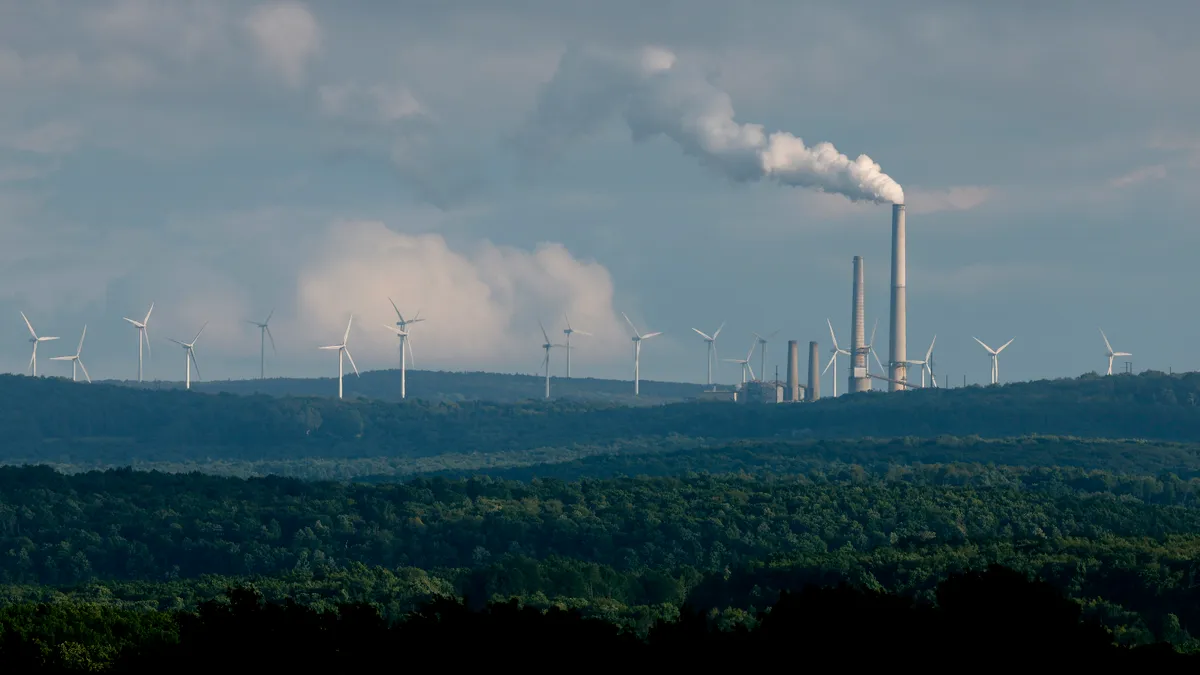Dive Brief:
- Dominion Energy Virginia filed its 2023 integrated resource plan with the State Corporation Commission on Monday detailing a range of possible resource additions by 2048, including up to 9 GW of new natural gas-fired capacity due to reliability concerns.
- While the IRP includes no planned retirements of carbon-emitting plants in the next 15 years, the vast majority of new power generation planned over that time period “is renewable, including all the offshore wind, onshore wind, solar and battery storage required under the Virginia Clean Economy Act,” Dominion Energy spokersperson Aaron Ruby said in an email. But “renewables alone cannot reliably serve the unprecedented growth in customer demand expected over the next 15 years,” he added.
- Dominion said that the PJM Interconnection’s 2023 forecast of peak and overall energy load growing by close to 5% and 7%, respectively, over the next decade is “driven primarily” by the growth of data centers in Virginia, and cited the outages during December’s winter storm Elliott as a key reason for the utility to diversify its generation.
Dive Insight:
Virginia Gov. Glenn Youngkin, R, praised the IRP in a Monday release and said that it “validates” the energy plan his office released last October, which proposed an “all-of-the-above approach” to energy that includes the use of natural gas, nuclear energy and renewables.
Dominion’s IRP takes a similar approach to the governor’s plan, proposing the deployment of new small modular reactors in four of its five potential pathways, and proposing new renewable energy and new natural gas generation in all five.
Over the next 25 years, the utility plans to add around 3 GW in wind capacity, 19 GW to 24 GW in solar capacity, and 1 GW to 10 GW of storage capacity. Dominion proposed adding 0.8 GW to 4.8 GW of small modular reactor, or SMR, capacity in four of the pathways. Dominion plans to add as much as 9 GW or as little as 0.9 GW in natural gas capacity.
But “the IRP is not an application to build specific projects, retire specific power stations or recover costs from our customers. It’s a long-term plan based on a snapshot in time of current technology, market conditions and forecasts. As these conditions evolve, so will our long-term plans,” Ruby noted.
Clean energy advocates criticized the plan and its fossil fuel components, with the Sierra Club saying in a Tuesday release that it “irresponsibly misses the mark on the economics and the urgency of the climate crisis” and that the utility’s “reliance on fossil-fueled generation” is being driven by steep increases in data center demand.
“The data center industry in Virginia achieved a peak metered load of almost 2.8 GW in 2022 and is expected to grow to 13 GW by 2038,” the Sierra Club said. The group also called SMRs and the Virginia City Hybrid Energy Center, which converts coal and biofuels into electricity, “costly” to customers.
Ruby said Dominion is confident SMR technology can be deployed in the next decade. “The federal government has invested billions of dollars in advanced research and development. The NRC certified the first design earlier this year, and other designs are expected to be approved over the next several years,” he said.
In an email, Clean Virginia Executive Director Brennan Gilmore called Dominion’s IRP “broken” and said that increased electricity demand due to the growth of data centers is the result of poor planning.
The plan “relies on utility-provided modeling and demand projections which have consistently proven incorrect and includes virtually no input from the broader community of stakeholders,” Gilmore said.
But “the IRP is based on the PJM load forecast, not Dominion Energy’s. That’s Virginia law,” Ruby said. “PJM has warned about grid reliability if baseload and dispatchable power generation is retired too early or if we rely too heavily on intermittent renewables,” he added.
The Virginia Clean Economy Act requires Dominion to generate 100% of its electricity from carbon-free sources by the end of 2045, but also “explicitly authorizes” the utility to petition the State Corporation Commission for relief on the basis of threats to service reliability, the IRP says.
Accordingly, though Dominion’s 25-year plan extends to 2048, the utility only accounts for 11 GW of plant retirements in two of its pathways, with none planned for the next fifteen years.
Dominion’s plan says that 70% of the “unanticipated failures” of generators across the PJM system during winter storm Elliott were failures of natural gas resources “likely driven by lack of fuel supply, lack of fuel purchases, or gas pipeline pressure challenges.”
The utility sees pipeline storage of gas and liquefied natural gas as some of its current options for reducing outage risk during peak demand.
Michael Doyle, a senior equity analyst for utilities at Edward Jones, said in an email that growth in power consumption in Virginia is likely to be “very healthy” due to data center growth and customer growth, increasing customer demand for reliability.
“I think reliability has become a key issue across the nation, but especially in this region after the winter storm in December 2022 led Dominion to ask its Virginia and North Carolina customers to conserve power to help it maintain reliability amid record low temperatures,” Doyle said.
Correction: This story has been updated to reflect the correct amount of small modular reactor capacity Dominion proposed.















